This piece was originally published waaaay back in 2014 by Anjali Rao.
Why bother defining a target audience? Isn’t it better just to lump everyone together? If my brand reaches out to everyone and their mom, someone is bound to like us, right? NO. NOT RIGHT! (CAPS STRESS URGENCY) That’s an expensive and ineffective strategy because the success of your entire influencer marketing campaign hinges on hitting certain metrics by partnering with influencers who can get your buyers to take certain actions.
You NEED to define a target audience for your product.
Why? Because without knowing who you’re targeting with your campaigns, your sponsored content – for the campaign you’ve spent weeks building – is going to have very little impact. And you don’t need some big, fancy piece of software and a bunch of explainer videos to teach you how to do this. Most of what you’ll need to figure out who you’re targeting (and what their deal is) can be found right in the dashboard of your brand’s social media account.
Time is money, and without a defined audience in place you may as well shred your Benjamins, weave them into a basket, and light that basket on fire.
Defining your target audience is crucial when it comes to marketing, and especially influencer marketing. Regardless of the business you’re in or the products/services you sell, relevant marketing demands deliberate targeting.

To achieve your influencer marketing goals (and we’ve literally written a book about it – grab a copy by pressing the big, ol’ button in the middle of this post), you need to know your target audience inside and out. This way you will be able to convert prospects into customers a lot easier. Uh… hello, BETTER ROI (we wrote a post on ROI, too)!
Hopefully, at this point, you’re at least somewhat convinced there’s merit in defining your audience on social media. Now, on to the good stuff. Let’s talk about how to find the right audience for your brand.
TLDR: Jump To…
- Definitions
- Kind of info to collect for demographic insights
- Kind of info to collect for psychographic insights
- Tools that collect demographic/psychographic info automatically

What and Who Is Your Target Audience?
Before we get into this, let’s make sure we’re working from the same basic definition of ‘target audience’.
Target Audience vs Target Market
While the terms “target market” and “target audience” are often used interchangeably, they’re actually different. Your target audience is the specific group of people you want to reach with your message, your brand, and your products. Think of your target market as the pool within which your target audience swims.
The target market refers to the larger group of people a company markets to, for example, men under the age of 35. The target audience, however, is typically a more specific subset of this group, e.g. college-educated millennial dads (with gen alpha kids) under 35 who watch sports and are health-conscious. Definitely, a part of your target market, but gets down to the nitty-gritty of what to consider when marketing to them, specifically.
So, who is your target audience?
Well, it’s not everybody, I can tell you that. And it may not even be millennials. (Geez… I can’t think of a company that wouldn’t like some of that barely-earned and poorly-spent millennial cash, but millennials can’t buy everything.)
And yeah, you can add millennial dollars to your wish list if you’re casting a wide net and hoping for your thing to be the next big rebirth of Hush Puppies (for all you Tipping Point fans out there) but why hope you hit your target? Just do the research, man!
Honing in on your target audience will take some initial effort on your part. That’s true. There are obviously a ton of things you could hone in on when defining your target audience, but we’re going to focus on two very important pieces of the puzzle: demographics & psychographics.
The First Step of Audience Targeting is Data. It’s ALWAYS Data.
This should go without saying but since we’re pretty thorough here, we’ll go ahead and say it: in order to do an effective deep dive into your audience, you’re going to need to find ways to collect some information from them.
And while there are many ways to do this and certain questions you should be asking yourself when doing so, you need to find an ethical way to do it… you know, so you don’t end up with a Facebook-sized scandal on your hands.
What Kind of Demographic Information Should I Collect?
In order to start the process of analyzing your target audience, you’ll need to consider their demographics, which is really just the basic info about the population that makes up your buyers. Easiest way to get the engine going? Questions. For example:
1) What is the age of your targeted audience? Are they tiny tots? Tweens? Elderly?
2) What is their gender? Male, female, both?
3) How much dinero are they pulling in annually?
4) What is their family situation like? Married? Kids? Single and ready to mingle?
5) What do they do for a living?
6) What is their ethnic background?
7) Are they educated?
8) Where do they live, work and play?
Coincidentally, these are also the types of questions you’ll ask when finding influencers followed by this audience.

The First Step of Audience Targeting is Data. It’s ALWAYS Data.
This should go without saying but since we’re pretty thorough here, we’ll go ahead and say it: in order to do an effective deep dive into your audience, you’re going to need to find ways to collect some information from them.
And while there are many ways to do this and certain questions you should be asking yourself when doing so, you need to find an ethical way to do it… you know, so you don’t end up with a Facebook-sized scandal on your hands.
What Kind of Demographic Information Should I Collect?
In order to start the process of analyzing your target audience, you’ll need to consider their demographics, which is really just the basic info about the population that makes up your buyers. Easiest way to get the engine going? Questions. For example:
1) What is the age of your targeted audience? Are they tiny tots? Tweens? Elderly?
2) What is their gender? Male, female, both?
3) How much dinero are they pulling in annually?
4) What is their family situation like? Married? Kids? Single and ready to mingle?
5) What do they do for a living?
6) What is their ethnic background?
7) Are they educated?
8) Where do they live, work and play?
Coincidentally, these are also the types of questions you’ll ask when finding influencers followed by this audience.

THIS ALL SEEMS A LITTLE INVASIVE – WE GET IT
I get it. This all seems kinda random, and even a bit intrusive. But even if you just think about things simply, you can see how gathering information about the people you’re targeting can help you.
For instance, knowing that 60 percent of your Instagram followers are in New York versus that surprising 19 percent of your followers who are in Ireland (somehow) can be super helpful when it’s time for you figure out when to post AND REPOST your clever little quips and amazing pictures to social media.
And demographic information will also play a key role in determining the type of content you create, long before psychographics ever enter the picture. Men in their 60s respond to different types of content than, say, single women in their late 20s.
Take a vertical like cannabis-related products…
A younger woman may be using CBD oil as part of her beauty regimen or to relieve foot pain from a pair of GORGEOUS stilettos, or for things like stress-reduction or chronic pain.
The older man is far less likely to include CBD as part of a daily beauty regimen or to relieve pain from a pair of heels that were hell on his feet. Most men won’t even be able to relate. He’s more likely to connect with your social media posts about reducing stress and minimize chronic pain, though.
We actually penned a series of posts on strategies for hyper-targeting different types of CBD buyers, if you’re interested.
Knowing the demography (or composition) of your target audience is critical for an effective marketing strategy. And answering these type of nosey little inquiries will allow you to serve your customers personalized content that helps connect with your brand and your message.
Really, any brand trends your particular industry might collect regarding the type of people who typically buy the products or services you are selling is important to consider. Not everyone will pick up what you’re putting down, so having demographic info on-hand arms you with an advantage that your customers will actually be glad you have.
This information puts you one step ahead of anyone marketing to folks who might NEVER buy their products. You want to focus on the people who do, or who might, given the right marketing strategy.

What Kind of Psychographic Information Should I Collect?
Demographics take a look at who your buyers are. Psychographics focus on why they buy. Psychographic information could include:
1) What do they value?
2) What type of lifestyle do they have?
3) What are their interests?
4) Are they impulsive shoppers or master-researching super savers?
5) Do they trust brands?
6) What special features would they find appealing?
7) What are their thoughts about your industry?
8) How do they behave?
9) Which brands do they like? Which do they actually buy? Which brands represent #goals?
10) What types of brands do they mention, follow and engage with on social media?
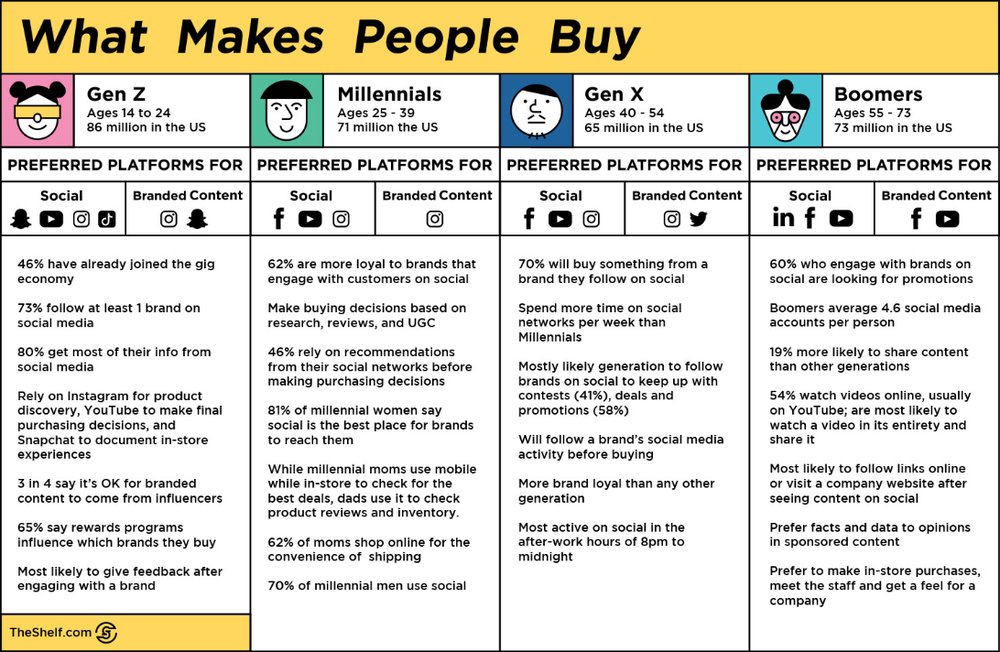
The information in a chart like the one above that shows the relationship different groups of people have with social media can make the difference between a successful social media campaign and an unsuccessful one.
Whereas before, you might have known who your demographic is, by coupling buyer behavior with demographic info, you can have a better understanding of how your particular buyer demographic uses things like social media to make decisions about what they will and won’t buy.
Combining demographics and psychographics gives your brand a clear picture of who your client is and why they typically buy what you’re selling.
After you have finished bombarding yourself with questions (remember, the more specific the better), gather all of your data and make a statement about your target audience combining demographic and psychographic information to create a mental profile. Think about ultimates. What ultimately is your demographic? What ultimately is your psychographic?
Once you have your defined target audience in hand, use their characteristics to have a one on one conversation with them when marketing. Perfecto! By assessing who you are speaking to you will undoubtedly be able to boost your company’s success in many different verticals.

Tools You May Already Have That’ll Help You Find Your Target Audience
I’m going to sum up this section in one sentence – your social media dashboard offers a ton of data besides just who’s liking, commenting on, and sharing your posts. If you use LinkedIn or Facebook or Instagram, you already have access to a nice stack of demographic info and some key psychographic insights. The same is true of your Google Analytics dashboard. And what’s cool about this is that it’s not going to cost you anything extra. No three-digital monthly subscription fees. Bonus: each platform offers a different data set than the others.
In this section, the goal isn’t to come up with an exhaustive list. It’s more about showing you what types of data are available in the free apps you’re already using for reach and brand lift (we wrote on brand lift, too). #yourewelcome
Google Analytics
Age, gender, and location are stats that most platforms will share with you. This screenshot from our Google Analytics dashboard helps us understand who we’re targeting. We pretty much cater to young adults between the ages of 18 and 34 years old, which makes sense. The Shelf is an influencer marketing platform and the influencers our clients partner with use the platform to submit content. So, we know these numbers don’t just represent blog readers (because what teenager is reading this blog, man?).
Our website users skew female. Also makes sense. But what’s a little more interesting is if you look in the left panel, you’ll see there are different types of data sets we can pull, from location data to the way in which people behave on the site, to the devices they’re using to access The Shelf.
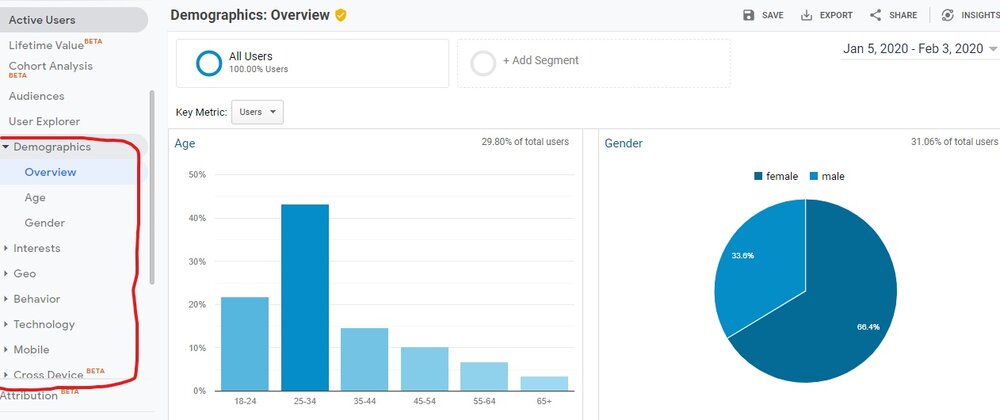
When we open the Interests, we can get information on the stuff our site users like.
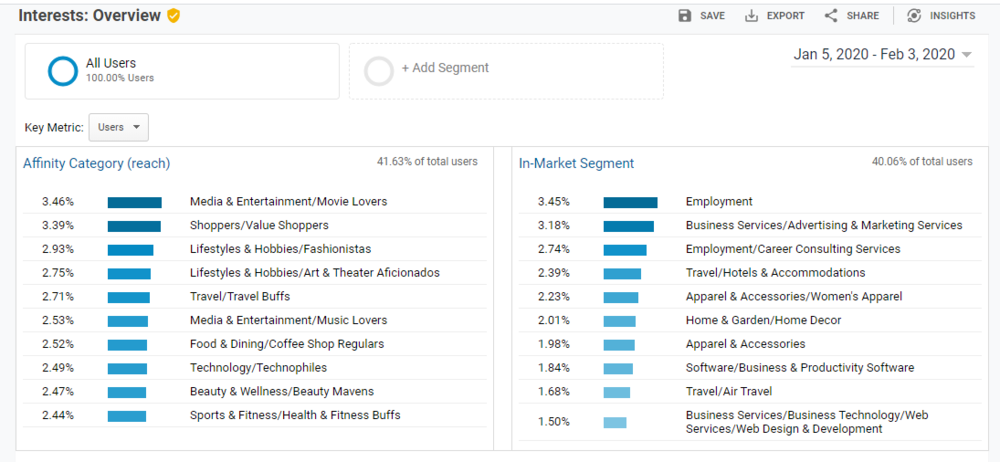
But you don’t have to be an SEO or marketing genius to read this stuff. Facebook offers quite a bit of audience insights as well, for both your fans (people who have Liked your page and now get to see the content you post to Facebook) and your Followers (the people who actually follow your page).
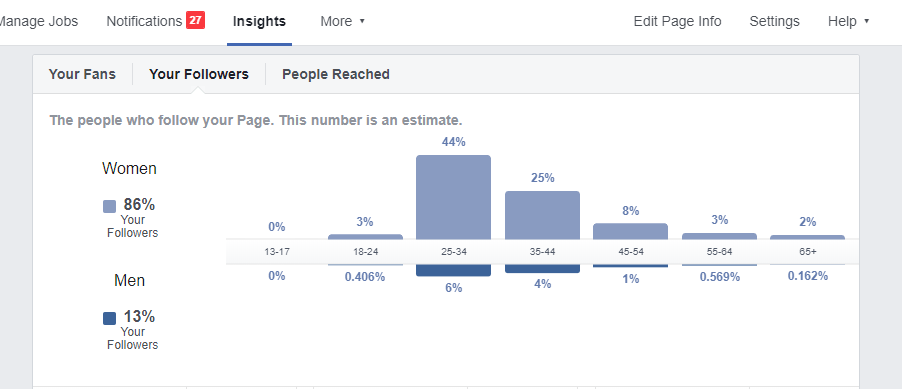
Facebook’s targeting capabilities are legendary at this point. The platform can produce insights on the its two billion users. For marketers, that means you can target just about anyone – any subcategory of shoppers, and even the most niched-down audience segments.
Facebook and Instagram are definitely platforms that favor the ultra-niche. It’s where people go to find their tribes.
Want to target modest Gen X moms with your biblically-inspired fat loss plan? Well, check out this Christian Keto group on Facebook. They’re pretty active. And you know what? I didn’t know about that group before I wrote this paragraph. I was just like, “what’s a niche group? Ketoers. No, smaller. Christian Ketoers.”
Did a Google search. Real group. No immodest progress pics. #thatsfrigginawesome

LinkedIn is another social network that provides useful insights about the community you’re connected to. The analytics tools are geared toward B2B marketing.
Take a look at the screenshot below. The stats showing are for the category of Seniority. You can basically gauge the percentage of your followers who may influence buying decisions. But you can also see which industries are following you, where your followers are , their specific job functions, and the sizes of the companies. This info is STELLAR for deciding what kinds of content would be most useful to your LinkedIn followers.
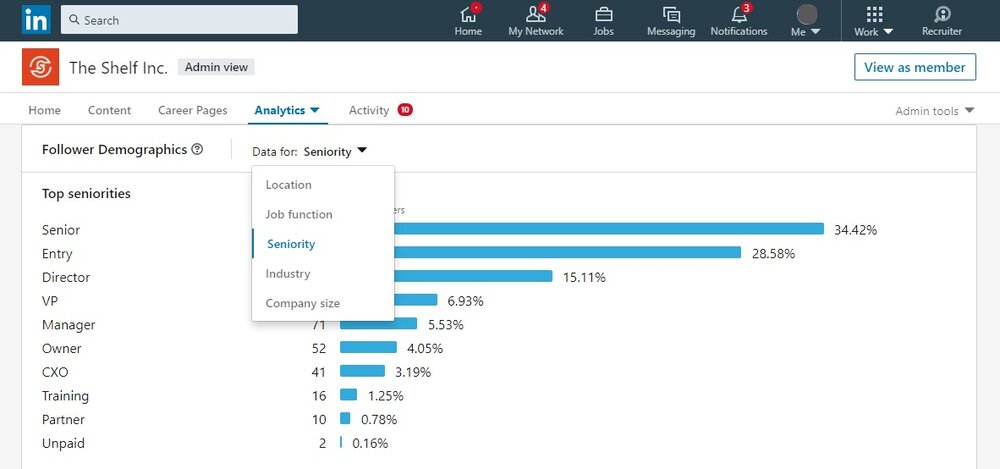
If you have a business or creator account, you can access Instagram insights from your mobile device. Insights aren’t available when you’re accessing the platform by desktop. One of the things I like about the Instagram insights is the nuance it offers.
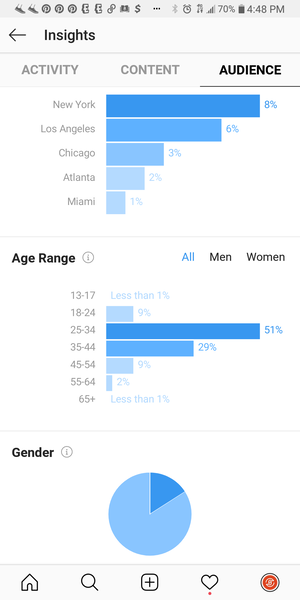
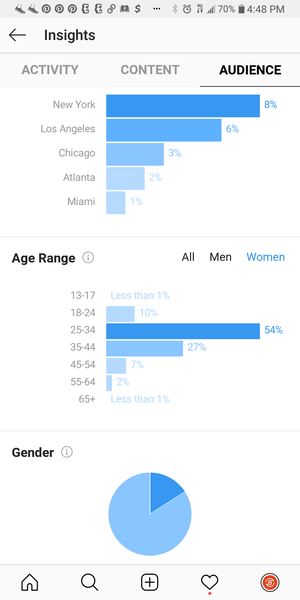
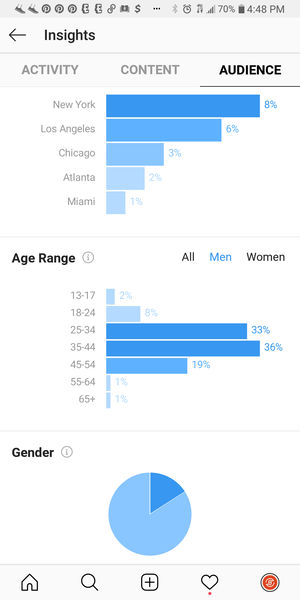
Pinterest does something really interesting for audience insights. Pinterest lets you compare your specific audience with all Pinterest users.
So, for instance, the content we post to Pinterest is mostly marketing-focused. Seems like a weird thing to post, but since we’ve been posting consistently, our engagement and follower numbers have increased. We repin tons of fashion and beauty pictures, and DIY stuff. But by and large, what we pin ourselves – marketing content.
So, if you look at our audience, you can see that the people who follow us are into things like marketing, advertising, and design.
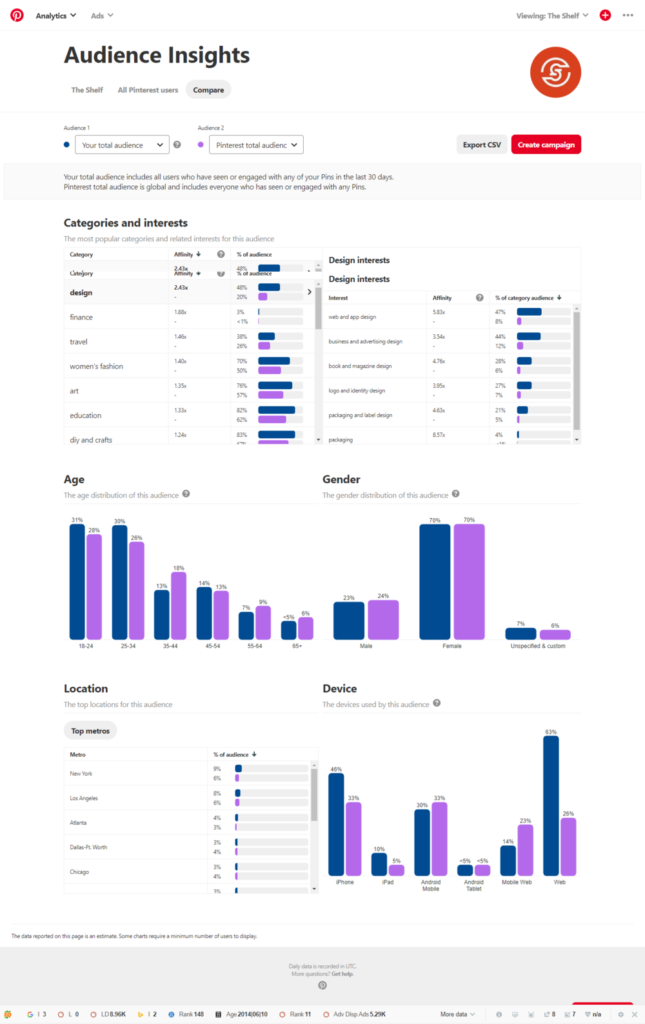
But Not Twitter
Twitter just did away with audience insights in January 2020 (TOTAL bummer), so you can no longer pull this kind of information (Marketingland) about your Twitter followers from that platform. Your Influencer Platform
Influencer marketing platforms are also treasure troves of audience insights. Our clients use The Shelf platform to determine if an influencer is a good fit for a partnership or one-off campaign, and it starts with an ample supply of data about the influencer’s audience.
I wanted to include this one because when you’re working with an influencer, having the demographic/psychographic info of their audiences is just as important as having that information for your audience. Take a look at the screenshot below of data we pulled on an influencer who was being considered for a campaign.

A quick scroll across this sucker and you’ll be able to pinpoint which sets of data are about the influencer (like content category, brand mentions, hashtags used) and which are about the influencer’s audience (like age, location (actually, I didn’t pull that info for this example, but you can grab it)).
This is super-important, too because ideally, the audience of your influencer partner contains large swathes of your target audience. If it doesn’t – meaning if the data you find out about potential influencer partners don’t align with what you already know about your audience, it’s not a good fit.
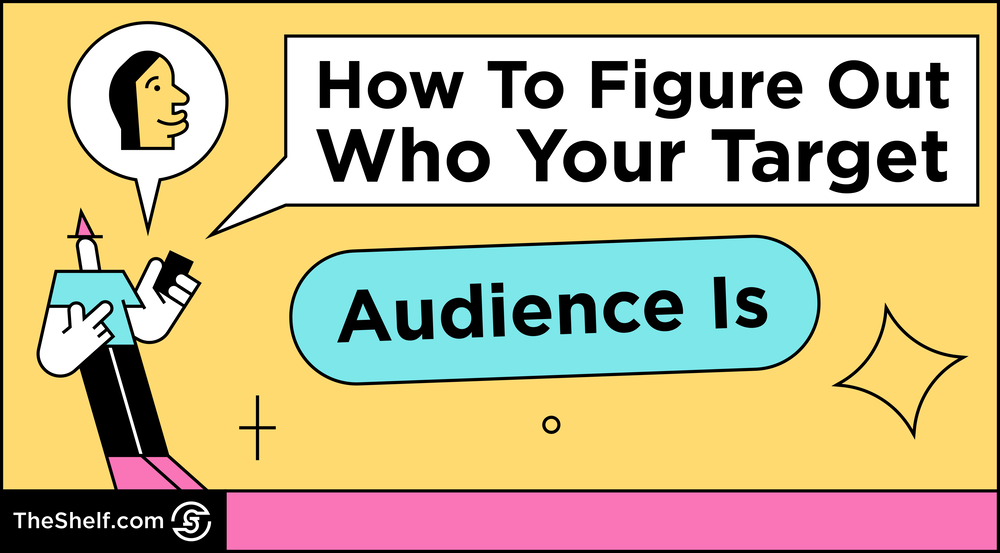
The Big Wrap-Up
So there you have it! Demographic and psychographic insights are the two pieces of a targeted marketing strategy that will help you build a campaign that resonates with the people who’ll ACTUALLY BUY from you.
You don’t have to buy expensive attribution-tracking data that someone on your team now has to learn to use (and spend countless hours on with the software’s onboarding team and later with their tech support team). Most of the information you need you can find in the dashboards of apps like LinkedIn, Google Analytics, Pinterest, and Facebook.
So go forth and conquer. Target superbly and collect those coins.







